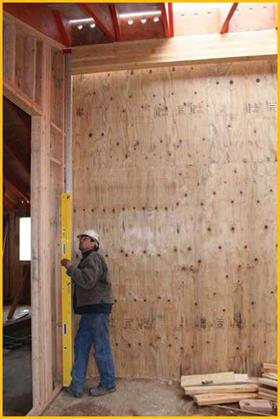Plumbing Tools
A level is the traditional tool for determining plumb. A laser can also be used. Whichever tool you use, you want to make sure you check it for true before you start. To check a level, hold it in position against a wall and read the bubble. Then turn it around and place it in the same position against the wall. If the bubble reads the same, then your level is accurate.
To check a laser use a similar method. Set it in place, and mark the bottom dot and the top dot. Then turn it around and align the bottom dot. If the top dot hits the same spot on the top of the wall that you marked, your laser is reading accurately.
Levels are accurate when the level is long enough to reach from the bottom plate to the top plate. An 8′ level will work fine for most residential walls. A 12′ extension level works for walls up to 12′. If the level does not reach from plate to plate, you have to figure that there will be some variance for the studs’ irregularities.

 Lasers are good for taller walls. Lasers are not dependent on perfect wood for determining plumb. Set the laser at the bottom, and read the distance you set at the bottom on your tap at the top of the wall. If you need to check plumb on a regular basis, the laser has the advantage of fitting in your pouch.
Lasers are good for taller walls. Lasers are not dependent on perfect wood for determining plumb. Set the laser at the bottom, and read the distance you set at the bottom on your tap at the top of the wall. If you need to check plumb on a regular basis, the laser has the advantage of fitting in your pouch.






Leave a reply